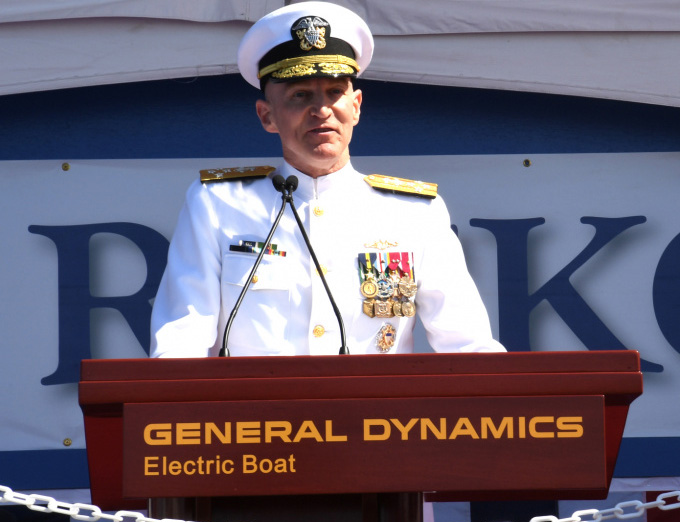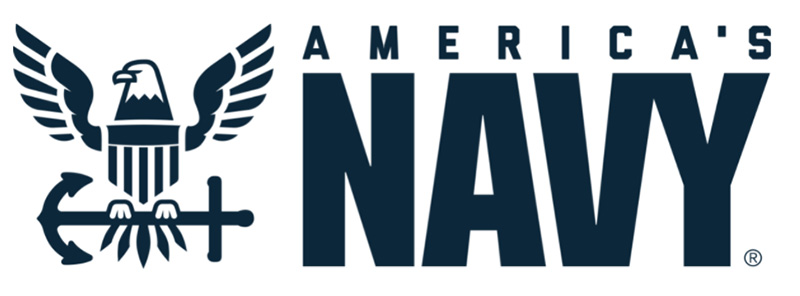
The Navy christened one of its newest Virginia-class attack submarines, the future USS Hyman G. Rickover (SSN 795), in honor of the “Father of the Nuclear Navy” on Saturday, July 31, 2021, at General Dynamics/Electric Boat, in Groton, Connecticut, a wholly owned subsidiary of General Dynamics.
Darleen Greenert is the ship sponsor. She has served in the U.S. Navy for 42 years as a naval officer, a volunteer and a devoted military spouse; her husband Jonathan Greenert is a former Chief of Naval Operations.
Ms. Greenert has contributed to the welfare of Navy and military families through her volunteer service, and has served as a senior advisor for numerous naval and military spouse organizations.
(Hear from the submarine spouse and the ships sponsor, Darleen Greenert, during the SSN 795 Rickover Keel Laying Ceremony. Courtesy of GD Electric Boat and YouTube. Posted on May 16, 2018.)
The submarine Rickover is the 22nd ship of the Virginia Class, with the central characteristic of the class being the modularity derived from the design/build approach, which supports efficient construction and mission capability.
This provides the U.S. Navy with a submarine class that advances the state-of-the-art with each succeeding ship.
Rickover’s adaptability makes it highly responsive to changing mission requirements.

Rickover and crew will operate under Submarine Squadron (SUBRON) FOUR whose primary mission is to provide attack submarines that are ready, willing, and able to meet the unique challenges of undersea combat and deployed operations in unforgiving environments across the globe. (Courtesy of the U.S. Navy by Chief Petty Officer Joshua Karsten)
“The future USS Hyman G. Rickover will play an important role in defending our nation during this time of strategic competition,” said the principal speaker was Adm. James Caldwell, director, Naval Nuclear Propulsion Program, Department of the Navy/ Department of Energy,
“It stands as proof of what teamwork – from civilian to contractor to military – can accomplish.”
“I am confident USS Hyman G. Rickover and its crew will proudly serve our country’s interest for decades to come, ensuring America remains strong.”
The future USS Hyman G. Rickover (SSN 795) is the second nuclear-powered fast attack submarine in recognition of Adm. Rickover, with the first Hyman G. Rickover (SSN 709) commissioned at Submarine Base, New London, in Groton, on July 21, 1984.
SSN 709 and its crew deployed 12 times until its decommissioning in December 2007.
Over the years, its decorations included the Atlantic Fleet Golden Anchor Award, Submarine Squadron Eight’s anti-submarine warfare white “A” and engineering red “E” awards and the prestigious Sixth Fleet “Hook ‘Em” award for anti-submarine warfare excellence.
Rickover, known as the “Father of the Nuclear Navy,” served in the Navy for 63 years on active duty, and his views touched matters of design, propulsion, education, personnel and professional standards.
(Hear briefly from a panel of distinguished U.S. Navy veterans will discuss the legacy of Admiral Rickover, considered by many as the father of the U.S. nuclear Navy. Courtesy of the Pritzker Military Museum & Library and YouTube. Posted on Mar. 20, 2020.)
Rickover’s team of engineers designed and constructed the first nuclear-powered submarine, USS Nautilus (SSN 571).
This accomplishment led to the world’s preeminent fleet of nuclear-powered submarines and aircraft carriers.
Virginia-class submarines are built to operate in the world’s littoral and deep waters while conducting anti-submarine warfare; anti-surface ship warfare; strike warfare; special operations forces support; intelligence, surveillance, and reconnaissance; irregular warfare; and mine warfare missions.
Their inherent stealth, endurance, mobility, and firepower directly enable them to support five of the six maritime strategy core capabilities – sea control, power projection, forward presence, maritime security and deterrence.
They are replacing Los Angeles-class submarines as they retire.
(For enemies of the United States, the U.S. Navy is a frightening adversary; but perhaps the most frightening thing about it is the fact that at any given moment, the Navy’s submarine force is patrolling the deep, carrying deadly weapons and skilled crews anywhere they are needed. The submarine force can operate in any environment, from the icy seas of the Arctic to the deep oceans of the world. It can accomplish a variety of missions as well, including long-range missile attacks, special forces delivery, anti-ship and submarine warfare, and many top secret missions. Courtesy of the U.S. Navy and YouTube.)
 To Learn More about Attack Class Submarines, go to https://www.navy.mil/Resources/Fact-Files/Display-FactFiles/Article/2169558/attack-submarines-ssn/.
To Learn More about Attack Class Submarines, go to https://www.navy.mil/Resources/Fact-Files/Display-FactFiles/Article/2169558/attack-submarines-ssn/.
AST strives to meet a 3 STAR trustworthiness rating, based on the following criteria:
- Provides named sources
- Reported by more than one notable outlet
- Includes supporting video, direct statements, or photos

















